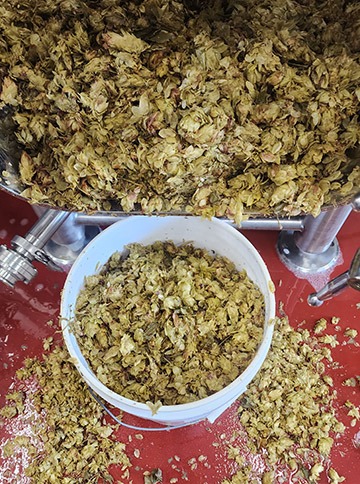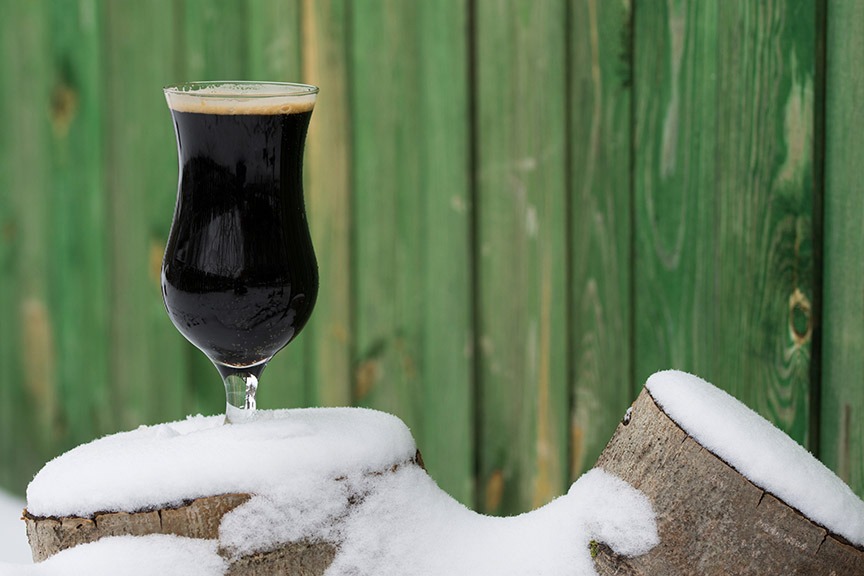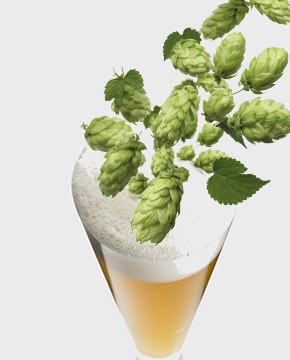Fruit Beer Brewing Techniques
I drank my first fruit beer around 1980. It was a Belgian kriek (that is cherry flavored), which I came across in South Africa. The fruit flavor was somewhat muted, but the sour edge of the beer made it quite refreshing on what was a very hot day. I must confess that I have been disappointed by fruit beers ever since then. Too many of those I have tried, from both craft and homebrewers, have fallen short — either tasting only of fruit and nothing else, or worse, just bland and muddy. Some, indeed, are little better than lightly flavored alcoholic drinks — what the Brits disparagingly call “alcopops.”
It is interesting that there is no fruit beer tradition in either Germany or Britain, despite the fact that in the latter there is a long tradition of making “country wines” based on various fruits. In fact, my first attempts at making fermented beverages were with such country wines. It was only in Belgium that fruit beers were produced, until American home and craft brewers powered onto the scene in the 1970s and 1980s onward. There is a sound reason for this and that is that Belgian brewers were adding fruit to already soured beers, and some acidity is essential to preserving fruit flavor in beer, as I shall discuss later.
The above may sound discouraging, but I don’t mean to put you off making fruit beer at all. Done properly, such beers can be quite rewarding and well worth making. But they must be done properly, with careful thought as to the effects you want to achieve. Just chucking a fruit you like into your favorite beer will result in something in which the best parts of both ingredients are lost. You need to have the right kind of fruit in the right kind of beer, and some fruits and some beers just will not fit together. Above all, your fruit beer should still be a beer and nothing else.
A good approach to fruit beer brewing is as follows:
- Ask yourself what you are really trying to achieve.
- Select the fruit on the basis of that first point.
- Match the beer to the fruit you have selected.
- Limit the use of hops.
Aims
The first point should be obvious; after all, if you don’t know what you are aiming at you’ll never know whether you hit it or not. So decide whether you are making a light, refreshing summer beer to be drunk quickly, or something stronger that might be kept for months or more. Or perhaps you just want something to take to a party that is suited to those drinkers who aren’t interested in flavorful, craft-oriented beers. Perhaps you are a bit jaded with hoppy, bitter, or roasted flavors and want to try something else for a new experience. Whatever you are after, just be clear about it; if you are not there’s the well-established fallback position of tasting a few commercial samples and deciding which one you like best. In fact, if you have never tried a fruit beer I strongly recommend that you do so before going to the effort of making your own.
The fruit
I have given priority to the choice of fruit here partly because that might be dictated for you by what is available in stores or your own garden. But partly also because your choice will determine the kind of base beer you need, since the intensity of fruit flavor varies greatly. For example, cherries and raspberries go well with strong or even dark beers, but can mask the delicate flavors of a light wheat beer. Conversely, peaches are very mild in flavor and will only work well with very light and gentle beers. You should be aware that fruit flavor may be quite different in a beer than in the fresh fruit itself. That is because the sugar in the fruit is part of its flavor profile, and most fruits also have a significant acid component. In a beer the sugar will be fermented out during brewing, and beer is relatively low in acidity in comparison to fruits, so the “fruit” flavor in beer may not at all be what you would expect from eating the fruit itself. For this reason, some brewers like to add some acid, such as citric, tartaric, malic, or a blend of these, all of which are available from winemaking suppliers.
In choosing the fruit, you also must decide in what form you will use the fruit — fresh-picked, fresh store-bought, frozen, canned and so on. Or are you going to take the easy way out and use a concentrated fruit flavor? The latter is much simpler to use as the flavoring can be added just prior to kegging or bottling and need not be directly involved in the brewing process. These concentrates can give a very intense flavor so just be careful to check the addition rate by adding a few drops (count them!) to a small sample of the beer, and scaling it up to the full volume of the brew. Personally, I find fruit beers that are flavored in this manner are somewhat disappointing and lack the appeal of beers brewed with actual fruit. Such concentrates do not add any acid to the brew, the absence of which, as discussed earlier, adversely affects fruit flavor. However, these concentrates should not be dismissed entirely, for they may work well as a “flavor adjuster” in a full-fruit brew if you are not quite satisfied with the result. If you are entering your beer in a competition, such topping-up may well be worth doing in order to give your entry some final polish.
An advantage of using concentrates is that it has no effect on original gravity, so your base beer will not change in its malt/alcohol balance, which makes design of the latter more straightforward.
If you use actual fruit you will be adding fermentable sugars, and will end up with a beer containing alcohol over and above that derived from the malt sugars. That means that it is easy to finish up with a beer that is too thin to balance the fruit flavor, so you need to take this into account when formulating your base beer.
Most fruits contain 10–15% sugar, depending upon ripeness, and the amount added usually varies from 0.5–4 lbs. (0.23–1.8 kg) for a 5-gallon (19-L) brew. You probably won’t know the exact sugar content of your fruit, so you will have to make an educated guess. If you use 1 lb. (0.45 kg) of fruit at 10% sugar you will add about 1 gravity point (that is 1.001), which is no big deal. But if your fruit contains 15% sugar and you want to add 6 lbs. (2.7 kg) of it, you will be adding about 8 gravity points. That would mean that if the malt-derived gravity was 1.040 (10 °P), your “real” original gravity (OG) would be 1.048 (11.9 °P), which is quite a big increase and could easily result in a thin beer, as all that extra sugar will be fermented out. All I can say here is “if in doubt, use a bit less.”
The fruits that seem to find most favor with brewers are cherries, raspberries, blackberries, blueberries, apricots and watermelon. Apples, plums, pears and many others give only a mild flavor to beer, as do peaches and strawberries whose flavor in any case tends to fade very quickly. Pumpkin beers of course are very popular, and the pumpkin is a fruit, but to me it has so little flavor that everything comes from the added spices, not from the fruit.
The chosen fruit has to be prepared in some way for use, and making a puree is often a good option. Many winemakers opt to remove pits from those fruits that have them, such as cherries, since they can contain hydrogen cyanide, although probably not in amounts significant enough to result in poisoning of the drinker. Some brewers prefer to use frozen fruit, since freezing tends to break down the fruit cells, thus making it easy to pulp the fruit and extract its flavors and sugars. I’ll give a recipe for watermelon beer showing one way to handle fresh fruit at the end of this article.
The choice of where to add fruit is limited because adding before or during the boil is likely to harm the very qualities you are trying to add. So brewers generally add it to the fermenter after the primary stage has subsided, when the yeast is still active. There is a possibility of introducing infections this way, although most brewers do not find it to be a problem, unless the pulp or fruit is allowed to form a cap sitting on top of the liquid. Some commercial brewers pasteurize their fruit, but that is not really practical for the amateur homebrewer. When fruit is added to the latter stages of the primary there often occurs a rapid, even explosive fermentation so you should make sure you have enough headspace to accommodate this and to prevent the pulp blocking things like fermentation airlocks and blow-off tubes.
The beer
You want something light and relatively neutral so the fruit flavor can come through. Aggressive hop flavors are undesirable as they will mask the fruit. But beware of making this beer so bland that only fruit flavors can be tasted. Some hop bitterness is good, as this makes a nice balance when it comes on the back of the palate after the taste of the fruit. But this should be fairly modest, 15–20 IBU at a maximum, all from hops added at the start of the boil. If you want character from late hops as well that’s okay, so long as it is just a trace, preferably of a citrusy hop.
Many brewers opt for a wheat beer as the base, and the wheat flavor does match well with some fruits, notably raspberries. But I often find that these are far too bland to match the fruit, and I like a base with a little more body. For the more delicate flavored fruits I would go for adding some Munich or Vienna malt along with 2-row pale and mashing at a relatively high temperature, say 151–153 °F (66–67 °C). For stronger flavored fruits I would go with a similar mix, but with some added lighter caramel malt, at say 20–40 °L. However, do not think that only pale beers are suited to this purpose, for many brewers have found raspberries, cherries, and even blackberries to work well with porters and even stouts.
The combinations are endless, more than I can cover here. One good approach is to think of a simple beer you like and then try to assess what fruit might go with that.
A recipe
Following is the recipe for Watermelon Ale, a seasonal beer that we brew at BrüRm@BAR in New Haven, Connecticut. We brew this seasonal beer just once a year, for we only use fresh fruit and it is quite a hard and messy job to cut up, take out and puree the flesh of some thirty or more watermelons.
The base beer is quite simple, but does incorporate some of the suggestions I have made earlier with regard to malt body. The end product really does taste like a beer, but is overlaid with that wonderfully refreshing taste of watermelon juice, just perfect for late spring/early summer drinking. It may just be our most popular special, and is usually gone long before you have a chance to say, “I’ll have another one of those!” Note that the extract recipe is very simple but you should find it just as tasty as the all-grain version.
Watermelon Ale
(5 gallons/19 L, all-grain)
OG = 1.045 FG = 1.012 IBU = 15 SRM = 7 ABV = 4.1%
Make sure to leave enough headspace in your fermenter to accommodate the watermelon pulp. The original gravity of this recipe is calculated without the watermelon pulp while the ABV is calculated with watermelon.
Ingredients
- 4 lbs. (1.8 kg) 2-row pale malt
- 3 lbs. (1.4 kg) Crisp Maris Otter pale ale malt
- 1.5 lbs. (0.68 kg) Munich malt (10 °L)
- 1 lb. (0.45 kg) Carapils® malt
- 3.5 AAU Willamette pellet hops (90 min.) (0.7 oz./20 g at 5% alpha acids)
- 0.25 oz. (7 g) Amarillo® pellet hops (0 min.)
- White Labs WLP002 (English Ale) or Wyeast 1968 (London ESB) yeast
- 0.5 gallon (2 L) pureed pulp of ripe watermelons
- Priming sugar (if bottling)
Step by Step
Mash grains for 90 minutes at 151–153 °F (66–67 °C) using 11 qts (10 L) water. Run off and sparge with hot water to collect 5.5–6 gallons (21-23 L) of wort and then boil 90 minutes with the Willamette hops added at the start.
Turn off heat, add Amarillo® hops and cool to 65–70 °F (18–21 °C). Pitch yeast, preferably as a 1-qt. (1-L) starter. By day five, the primary fermentation should have subsided; take melon(s) and scrape the pulp from the rind into a blender to get about 0.5 gallon (2 L) of pulp. Puree the pulp for about 30 seconds then add it to the fermenter, which should have a good headspace above the liquid. Fermentation of the fruit sugars should be complete within 1–3 days and the beer can be transferred to the secondary. In a week or so siphon the beer off the pulp and bottle or keg in the usual way.
Watermelon Ale
(5 gallons/19 L, extract only)
OG = 1.045 FG = 1.012 IBU = 15 SRM = ~10 ABV = 4.1%
Ingredients
- 6.2 lbs. (2.8 kg) amber liquid malt extract
- 3.5 AAU Willamette pellet hops (90 min.) (0.7 oz./20 g at 5% alpha acids)
- 0.25 oz. (7 g) Amarillo® pellet hops (0 min.)
- White Labs WLP002 (English Ale) or Wyeast 1968 (London ESB) yeast
- 0.5 gallon (2 L) pureed pulp of ripe watermelons
- Priming sugar (if bottling)
Step by Step
Try to find an amber malt extract made with a significant proportion of Munich malt. Dissolve the extract in 3 gallons (11 L) of hot water, then bring it up to 5 gallons (19 L) with hot water and boil 60 minutes, adding the Willamette hops at the start. Turn off heat, add Amarillo® hops and cool to 65–70 °F (18–21 °C). Pitch yeast, preferably as a 1-qt. (1-L) starter. By day five, the primary fermentation should have subsided; take melon(s) and scrape the pulp from the rind into a blender to get about 0.5 gallon (2 L) of pulp. Puree the pulp for about 30 seconds then add it to the fermenter, which should have a good headspace above the liquid. Fermentation of the fruit sugars should be complete within 1–3 days and the beer can be transferred to the secondary. In a week or so siphon the beer off the pulp and bottle or keg in the usual way.







